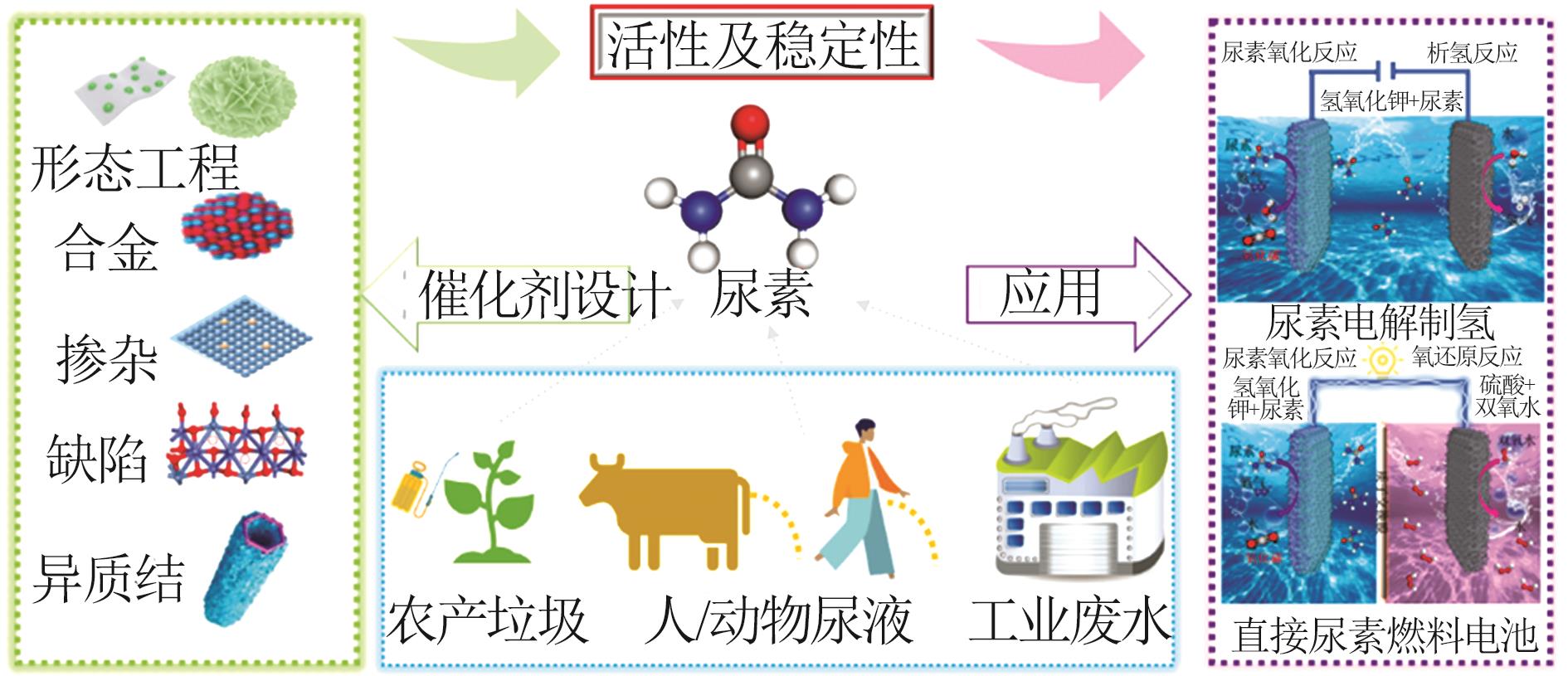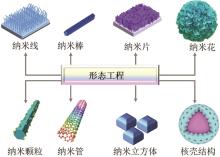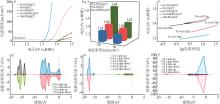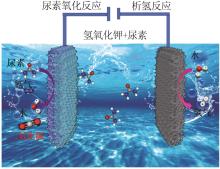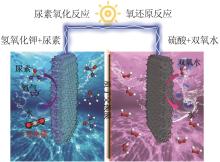Inorganic Chemicals Industry ›› 2025, Vol. 57 ›› Issue (2): 26-35.doi: 10.19964/j.issn.1006-4990.2024-0111
• Reviews and Special Topics • Previous Articles Next Articles
Research progress of microstructure-regulated catalysts for urea oxidation reactions
- School of Materials and Chemistry,University of Shanghai for Science and Technology,Shanghai 200093,China
-
Received:2024-04-24Online:2025-02-10Published:2024-04-12
CLC Number:
Cite this article
LUO Chengling, FAN Xiaofan. Research progress of microstructure-regulated catalysts for urea oxidation reactions[J]. Inorganic Chemicals Industry, 2025, 57(2): 26-35.
share this article
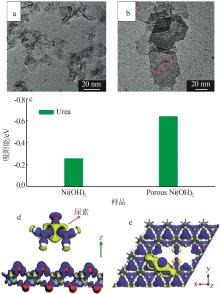
Fig.3
HRTEM images of β-Ni(OH)2 nanosheets(a,b), adsorption energies of urea molecules on Ni(OH)2 nanosheets with and without a porous structure(c),and schematic representation of urea molecules adsorbed on surface of porous Ni(OH)2 nanosheets and corresponding charge density difference(d,e)[32]"

| 1 | JACOBSON M Z.Review of solutions to global warming,air pollution,and energy security[J].Energy & Environmental Science,2009,2(2):148-173. |
| 2 | 刘啸,谢镭,邓霁峰,等.海绵负载Co-B催化剂催化硼氢化钠水解制氢性能研究[J].无机盐工业,2023,55(12):146-151. |
| LIU Xiao, XIE Lei, DENG Jifeng,et al.Study on performance of sponge supported Co-B catalyst for hydrogen generation from catalytic hydrolysis of sodium borohydride[J].Inorganic Chemicals Industry,2023,55(12):146-151. | |
| 3 | XU Xianxian, ZHOU Quan, YU Dehai.The future of hydrogen energy:Bio-hydrogen production technology[J].International Journal of Hydrogen Energy,2022,47(79):33677-33698. |
| 4 | SONG Jiajia, WEI Chao, HUANG Zhenfeng,et al.A review on fundamentals for designing oxygen evolution electrocatalysts[J].Che- mical Society Reviews,2020,49(7):2196-2214. |
| 5 | ZHU Dongdong, GUO Chunxian, LIU Jinlong,et al.Two-dimensional metal-organic frameworks with high oxidation states for efficient electrocatalytic urea oxidation[J].Chemical Communications,2017,53(79):10906-10909. |
| 6 | LAN Rong, TAO Shanwen, IRVINE J T S.A direct urea fuel cell-power from fertiliser and waste[J].Energy & Environmental Science,2010,3(4):438-441. |
| 7 | AMIN I, BHAT S A, BHAT M M,et al.Pt x Ag100- x nano-alloy decorated N-doped reduced graphene oxide:A promising electrocatalyst for direct urea fuel cells[J].New Journal of Chemistry,2023,47(48):22146-22156. |
| 8 | KAKATI N, MAITI J, LEE K S,et al.Hollow sodium nickel fluoride nanocubes deposited MWCNT as an efficient electrocatalyst for urea oxidation[J].Electrochimica Acta,2017,240:175-185. |
| 9 | SINGH R K, RAJAVELU K, MONTAG M,et al.Advances in catalytic electrooxidation of urea:A review[J].Energy Technology,2021,9(8):2100017. |
| 10 | WANG Hongdan, ZHENG Xingqun, FANG Ling,et al.Urea electrooxidation in alkaline environment:Fundamentals and applications[J].ChemElectroChem,2023,10(13):e202300138.. |
| 11 | REBIAI L, MULLER-BOUVET D, BENYAHIA R,et al.Photoelectrocatalytic conversion of urea under solar illumination using Ni decorated Ti-Fe2O3 electrodes[J].Electrochimica Acta,2023,438:141516. |
| 12 | BOGGS B K, KING R L, BOTTE G G.Urea electrolysis:Direct hydrogen production from urine[J].Chemical Communications,2009(32):4859-4861. |
| 13 | HUANG Shoushuang, WU Ye, FU Jie,et al.Hierarchical CoFe LDH/MOF nanorods array with strong coupling effect grown on carbon cloth enables efficient oxidation of water and urea[J].Nanotechnology,2021,32(38):385405. |
| 14 | JI Xinyang, ZHANG Yongxia, MA Zhuo,et al.Oxygen vacancy-rich Ni/NiO@NC nanosheets with Schottky heterointerface for efficient urea oxidation reaction[J].ChemSusChem,2020,13(18):5004-5014. |
| 15 | LI Jiaxin, CUI Hongyi, DU Xiaoqiang,et al.The controlled synthesis of nitrogen and iron co-doped Ni3S2@NiP2 heterostructures for the oxygen evolution reaction and urea oxidation reaction[J].Dalton Transactions,2022,51(6):2444-2451. |
| 16 | RASAL A S, CHEN HAO ming, YU W Y.Electronic structure engineering of electrocatalyst for efficient urea oxidation reaction[J].Nano Energy,2024,121:109183. |
| 17 | ZHAO Xiaolong, WANG Yifei, ZHANG Yingguang,et al.Ni-Fe layered double hydroxide nanosheets supported on exfoliated graphite for efficient urea oxidation in direct urea fuel cells[J].ChemSusChem,2022,15(7):e202102614. |
| 18 | LI Linfeng, ZHANG Xia, HUMAYUN M,et al.Manipulation of electron spins with oxygen vacancy on amorphous/crystalline co-mposite-type catalyst[J].ACS Nano,2024,18(1):1214-1225. |
| 19 | ZHU Xiaojiao, DOU Xinyu, DAI Jun,et al.Metallic nickel hydroxide nanosheets give superior electrocatalytic oxidation of urea for fuel cells[J].Angewandte Chemie,2016,55(40):12465-12469. |
| 20 | LI Yuyu, LUO Fang, XIE Yuhua,et al.Oxygen vacancies in α-Ni(OH)2porous nanoflowers promote urea oxidation[J].International Journal of Hydrogen Energy,2023,48(25):9155-9162. |
| 21 | WU Zhipeng, LU Xuefeng, ZANG Shuangquan,et al.Non-noble-metal-based electrocatalysts toward the oxygen evolution reaction[J].Advanced Functional Materials,2020,30(15):1910274. |
| 22 | FENG Dongmei, YE Runze, TONG Yun,et al.Engineering cobalt molybdate nanosheet arrays with phosphorus-modified nickel as heterogeneous electrodes for highly-active energy-saving water splitting[J].Journal of Colloid and Interface Science,2023,636:425-434. |
| 23 | GUO Xin, QIU Longyu, LI Menggang,et al.Accelerating the generation of NiOOH by in situ surface phosphating nickel sulfide for promoting the proton-coupled electron transfer kinetics of urea electrolysis[J].Chemical Engineering Journal,2024,483:149264. |
| 24 | LI Ruopeng, LI Yaqiang, YANG Peixia,et al.Key roles of interfacial OH– ion distribution on proton coupled electron transfer kinetics toward urea oxidation reaction[J].Small,2023,19(30):2302151. |
| 25 | LIU Mengying, ZOU Wenhong, QIU Silong,et al.Active site tailoring of Ni-based coordination polymers for high-efficiency dual-functional HER and UOR catalysis[J].Advanced Functional Materials,2024,34(3):2310155. |
| 26 | WAN Jun, WU Zhiao, FANG Guangyu,et al.Microwave-assisted exploration of the electron configuration-dependent electrocatalytic urea oxidation activity of 2D porous NiCo2O4 spinel[J].Journal of Energy Chemistry,2024,91:226-235. |
| 27 | YANG Ming, GE Wanyu, LIU Zirui,et al.Synthesis of defective Ni-Mn layered double hydroxides nanosheets via alkali-assisted Mo doping for urea electro-oxidation[J].Fuel,2024,356:129626. |
| 28 | MOTTAKIN M, SELVANATHAN V, RAZALI S A,et al.Facile electrodeposition of biphasic CuS x /CoS x nanostructures as bifunctional electrocatalysts for seawater splitting[J].Electrochimica Acta,2023,463:142861. |
| 29 | DING Haoran, ZHAO Zhanhong, ZENG He,et al.Heterojunction-induced local charge redistribution boosting energy-saving hydrogen production via urea electrolysis[J].ACS Materials Letters,2024,6(3):1029-1041. |
| 30 | LIU Yi, YANG Zhihui, ZOU Yuqin,et al.Trace cobalt doping and defect engineering of high surface area α-Ni(OH)2 for electrocatalytic urea oxidation[J].Energy & Environmental Materials,2024,7(2):12576. |
| 31 | LIU Jiameng, HE Linghao, TAO Zheng,et al.Ferric oxide nanocrystals-embedded Co/Fe-MOF with self-tuned d-band centers for boosting urea-assisted overall water splitting[J].Small,2024,20(11):2306273. |
| 32 | YANG Wenlong, YANG Xianpeng, LI Bijun,et al.Ultrathin nickel hydroxide nanosheets with a porous structure for efficient electrocatalytic urea oxidation[J].Journal of Materials Chemistry A,2019,7(46):26364-26370. |
| 33 | ZHONG Mengxiao, LI Weimo, WANG Ce,et al.Synthesis of hierarchical nickel sulfide nanotubes for highly efficient electrocatalytic urea oxidation[J].Applied Surface Science,2022,575:151708. |
| 34 | MOTT D, LUO Jin, NJOKI P N,et al.Synergistic activity of gold-platinum alloy nanoparticle catalysts[J].Catalysis Today,2007,122(3/4):378-385. |
| 35 | DU Meng, LI Xinran, PANG Huan,et al.Alloy electrocatalysts[J].EnergyChem,2023,5(2):100083. |
| 36 | ZHANG Kuanjian, WANG Shaoxia, LI Xinyue,et al.Phase segregation in Cu0.5Ni0.5 alloy boosting urea-assisted hydrogen production in alkaline media[J].Small,2023,19(28):2300959. |
| 37 | CHEN Zhijie, ZHENG Renji, ZOU Haiyuan,et al.Amorphous iron-doped nickel boride with facilitated structural reconstruction and dual active sites for efficient urea electrooxidation[J].Chemical Engineering Journal,2023,465:142684. |
| 38 | LI Ping, HUANG Yuqi, OUYANG Xiao,et al.Unusual hcp Ni with metal and non-metal dual doping modulation to realize boosted urea oxidation[J].Chemical Engineering Journal,2023,464:142570. |
| 39 | ZHANG Quan, KAZIM F M, MA Shuangxiu,et al.Nitrogen dopants in nickel nanoparticles embedded carbon nanotubes promote overall urea oxidation[J].Applied Catalysis B:Environmental,2021,280:119436. |
| 40 | XIE Junfeng, YANG Xueying, XIE Yi.Defect engineering in two-dimensional electrocatalysts for hydrogen evolution[J].Nanosc- ale,2020,12(7):4283-4294. |
| 41 | TONG Yun, CHEN Pengzuo, ZHANG Mengxing,et al.Oxygen vacancies confined in nickel molybdenum oxide porous nanosheets for promoted electrocatalytic urea oxidation[J].ACS Catalysis,2018,8(1):1-7. |
| 42 | LI Meng, WU Xiaodong, LIU Kun,et al.Nitrogen vacancies enriched Ce-doped Ni3N hierarchical nanosheets triggering highly-efficient urea oxidation reaction in urea-assisted energy-saving electrolysis[J].Journal of Energy Chemistry,2022,69:506- 515. |
| 43 | LI Zhenxing, HU Mingliang, WANG Ping,et al.Heterojunction catalyst in electrocatalytic water splitting[J].Coordination Chemistry Reviews,2021,439:213953. |
| 44 | XU Xiaocheng, LIAO Haijun, HUANG Le,et al.Surface reconstruction and directed electron transport in NiSe2/MoSe2 Mott-Schottky heterojunction catalysts promote urea-assisted water sp-litting[J].Applied Catalysis B:Environmental,2024,341:123312. |
| 45 | LIU Jingchao, LI Jianming, SHAO Mingfei,et al.Directed synthesis of SnO2@BiVO4/Co-Pi photoanode for highly efficient photoelectrochemical water splitting and urea oxidation[J].Journal of Materials Chemistry A,2019,7(11):6327-6336. |
| 46 | 马超,胡洁琼,谢明,等.铂金镍纳米合金的制备研究进展[J].无机盐工业,2023,55(9):26-32. |
| MA Chao, HU Jieqiong, XIE Ming,et al.Research progress of preparation of Pt-Au-Ni nanoalloys[J].Inorganic Chemicals Industry,2023,55(9):26-32. | |
| 47 | 武鲁明,于海斌,王亚权.多孔碳基非贵金属氧还原电催化剂研究进展[J].无机盐工业,2023,55(10):13-23. |
| WU Luming, YU Haibin, WANG Yaquan.Research progress of porous carbon-based non noble metal electrocatalysts for oxygen reduction[J].Inorganic Chemicals Industry,2023,55(10):13-23. | |
| 48 | YANG Linlin, HE Ren, WANG Xiang,et al.Self-supported NiO/CuO electrodes to boost urea oxidation in direct urea fuel cells[J].Nano Energy,2023,115:108714. |
| [1] | ZHANG Bao, QUAN Kaidong, WANG Yongfeng, HAN Fei, SHI Aiwen, LIU Xin, WANG Xiaomin. Study on fabrication of nanoflower-like Fe y -NiCoS x @NF catalysts and their application in hydrogen evolution and oxygen evolution during seawater electrolysis [J]. Inorganic Chemicals Industry, 2025, 57(2): 130-137. |
| [2] | XIE Jiang, GUO Ge, QIU Jie. Treatment of methylene blue simulated wastewater by supported activated carbon particle with three-dimensional electrode method [J]. Inorganic Chemicals Industry, 2024, 56(5): 78-86. |
| [3] | ZHOU Xuan, LI Mengrui, CHEN Yichen, FAN Huiqiang, WANG Bin, YUAN Gang. Research progress of nickel-based phosphide composites in improving of catalytic water electrolysis for hydrogen evolution performance [J]. Inorganic Chemicals Industry, 2024, 56(4): 8-15. |
| [4] | CHEN Xingliang, FAN Wenjuan, CHANG Hui, HUANG Haiping, JIANG Zhiqiang. Study on collaborative strategy between Fe3+ and Ni-based metal-organic frameworks for boosting electrocatalytic oxygen evolution [J]. Inorganic Chemicals Industry, 2024, 56(2): 152-158. |
| [5] | CHEN Junxue, MO Jianxin, ZHOU Zhiyu, LI Zhonglin, WANG Ding, LI Yuping, HU Yongjun, JIANG Xuexian, LI Yibing. Study on synthesis of NaFe x Cr y (SO4)2(OH)6 and their electrochemical properties [J]. Inorganic Chemicals Industry, 2023, 55(8): 71-76. |
| [6] | WU Luming, YU Haibin, WANG Yaquan. Study on preparation of porous carbon materials and oxygen reduction properties of their metal phosphide [J]. Inorganic Chemicals Industry, 2023, 55(4): 104-110. |
| [7] | TANG Hu,LIU Fang. Study on preparation of molybdenum cobalt binary sulfide and its performance in water splitting [J]. Inorganic Chemicals Industry, 2022, 54(2): 65-71. |
| [8] | ZHENG Yangzi,JIN Mingshang. Strategy to improve catalytic performance of Pt-based core-shell catalysts for fuel cells [J]. Inorganic Chemicals Industry, 2022, 54(11): 1-7. |
| [9] | Yang Huanhuan,Yu Binlu,Wang Jiahong,Yu Xuefeng. Preparation,surface functionalization and photoelectrocatalysis of two-dimensional black phosphorus [J]. Inorganic Chemicals Industry, 2021, 53(5): 13-20. |
| [10] | CHEN Jingjuan,LÜ Lin,WAN Houzhao,WANG Hao. Recent progress on Cu-based chalcogenides for electrocatalytic carbon dioxide reduction to formate [J]. Inorganic Chemicals Industry, 2021, 53(12): 14-20. |
| [11] | Ma Ruixiao,Xu Juan,Zhang Yanhui. Application status of attapulgite-based composite materials in field of catalysis [J]. Inorganic Chemicals Industry, 2021, 53(10): 22-27. |
| [12] | Liu Yanrui,Ge Junying,Zhang Zhaogui,Liu Yuchen. Synthesis and electrochemical properties of nano-sized Pt-Ir particle by electrodeposition method [J]. Inorganic Chemicals Industry, 2020, 52(9): 66-69. |
| [13] | Long Junxi,Xu Xuetang,Wang Fan. Preparation of porous CoFe LDH nanosheets electrocatalyst by low-temperature co-precipitation method [J]. Inorganic Chemicals Industry, 2020, 52(12): 98-103. |
| [14] | Huang Zhenxu,He Huanhuan,Jia Panpan,Chen Tiwei,Wei Shiqian. Synthesis of graphene by hydrothermal method and its electrocatalytic property on ascorbic acid [J]. Inorganic Chemicals Industry, 2020, 52(11): 29-32. |
| Viewed | ||||||
|
Full text |
|
|||||
|
Abstract |
|
|||||
|
||


